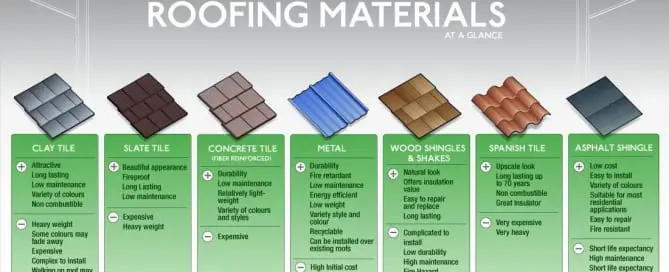When it comes to choosing the right roofing material for your home, there are numerous options available, each with its own set of advantages and disadvantages. The right choice can enhance the aesthetic appeal of your home, improve energy efficiency, and increase the overall value of your property. Here, we explore the top 5 roofing materials, highlighting their pros and cons to help you make an informed decision.
1. Asphalt Shingles
Pros:
- Cost-Effective: Asphalt shingles are one of the most affordable roofing materials available.
- Easy Installation: They are relatively easy to install, which can lower labor costs.
- Versatility: Available in a variety of colors and styles, they can match almost any home exterior.
- Durability: Can last up to 20-30 years with proper maintenance.
- Fire Resistance: Some types have a high fire resistance rating.
Cons:
- Shorter Lifespan: Compared to other materials, asphalt shingles have a shorter lifespan.
- Environmental Impact: They are made from petroleum products and are not recyclable.
- Susceptibility to Weather: They can be damaged by severe weather conditions such as high winds and hail.
2. Metal Roofing
Pros:
- Longevity: Metal roofs can last 40-70 years, making them a long-term investment.
- Durability: They can withstand extreme weather conditions, including heavy snow, rain, and wind.
- Energy Efficiency: Reflective properties help reduce cooling costs.
- Eco-Friendly: Often made from recycled materials and fully recyclable at the end of their life.
Cons:
- Cost: Higher upfront cost compared to asphalt shingles.
- Noise: Can be noisier during rain or hail unless proper insulation is installed.
- Expansion and Contraction: Metal can expand and contract with temperature changes, potentially leading to a less secure fit over time.
3. Wood Shingles and Shakes
Pros:
- Aesthetic Appeal: Provide a natural, rustic look that can enhance the beauty of certain home styles.
- Insulation: Good natural insulation properties, helping to reduce energy costs.
- Longevity: Can last up to 30-40 years with proper care.
Cons:
- Maintenance: Require regular maintenance to prevent mold, rot, and insect damage.
- Fire Risk: Higher risk of fire unless treated with a fire retardant.
- Cost: Generally more expensive than asphalt shingles.
4. Clay and Concrete Tiles
Pros:
- Durability: Extremely durable and can last over 50 years.
- Fire Resistance: Naturally fire-resistant, adding an extra layer of safety.
- Aesthetic Variety: Available in a variety of colors and styles, suitable for Mediterranean, Spanish, and Southwestern homes.
Cons:
- Weight: Very heavy, which may require additional structural support.
- Cost: High material and installation costs.
- Fragility: Can be fragile and break if walked on or impacted by heavy objects.
5. Slate Roofing
Pros:
- Elegance: Offers a unique, high-end appearance that can significantly boost curb appeal.
- Longevity: Can last over 100 years with proper maintenance.
- Fire Resistance: Naturally fire-resistant.
- Eco-Friendly: Made from natural stone and fully recyclable.
Cons:
- Cost: One of the most expensive roofing materials available.
- Weight: Extremely heavy, requiring reinforced roofing structures.
- Installation: Requires specialized and experienced installers, which can add to the cost.
Conclusion
Choosing the right roofing material involves considering various factors, including cost, durability, aesthetic appeal, and the specific needs of your home. By understanding the pros and cons of each option, you can make a more informed decision that will ensure your roof not only looks great but also stands the test of time. Whether you prioritize cost-effectiveness, longevity, or style, there’s a roofing material out there that’s perfect for your home.

